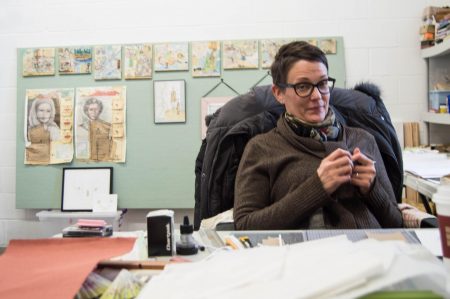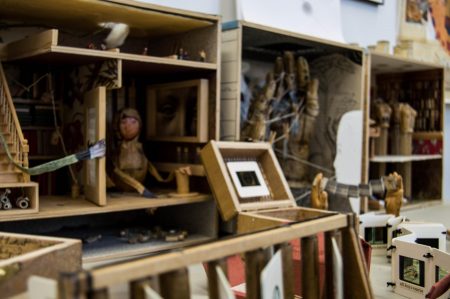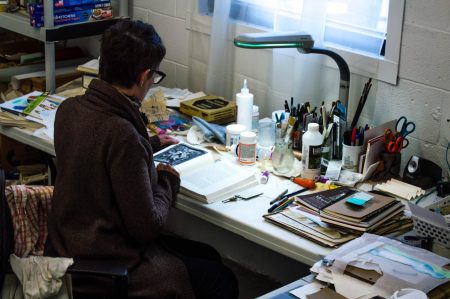An odd feeling creeps into my mind while sitting in Karen McGarry’s Brazee Street studio. The feeling that the many small figures strewn about the space — mannequin parts, cigarette-smoking Barbie dolls, old stop-motion animation dolls — must get up and have lives of their own when no one is around. That is the feeling McGarry told me she hopes her artwork evokes in viewers.
“I love the notion of somebody coming to a scene and deciding what they want the story to be,” she said. “The narrative gets generated by whoever is looking at it.”

McGarry is an artist and educator, most recently based in Cincinnati. She has lived all around the world — from Michigan, to Chicago, to London, to Singapore. But, within the walls of her all-white studio, with hands clasped around a warm cup of coffee, she looks quite at home.
McGarry and I spoke about being an artist and an educator, arts-inclusive approaches to STEM education, and processing information and research through art.
What role does education play in your artistic practice?
KM: It is pretty front and center. Personally, because I feel I am continually learning. I deal with this idea of “becoming.” I feel like I’m never “there.” I am always en route to some place. They call it “ideological becoming” — it’s not my own theory. But, I love getting lost in theory. I love getting lost in language and what happens within different kinds of communication. Whether we are communicating verbally, visually, through space.
So, I’m always educating myself. But I always see what I do as things that could educate or illuminate something for someone else. Once I started thinking about learning and going to college, I found I never wanted to stop being in school. What my early mentors offered me, I wanted to be able to offer others.
The space of an educator or researcher is a space that I didn’t know I could occupy. It is not traditionally a space that women occupy — sitting around thinking about theory. Most of the people I read who are theory-based are usually men; other than in subjects like women’s studies, where those spaces are generated and fueled by women’s voices.

A subject you have researched and written about is “STEAM,” an idea that includes the Arts in our STEM-based education systems. Can you tell me about that and how you have worked with that idea?
KM: It is a matter of thinking about STEM — Science, Technology, Engineering, Mathematics — but thinking about where innovation and creative thinking fit into the picture. Because, all of those subjects need that other little piece. I think I was still doing my master’s in art education when STEM initiatives came out. Everybody in the art department was confused about where art fit in. How do you design something or make something new if you’re not working with the kind of thinking that isn’t about getting a right answer all the time?
I tried to make STEAM a focus and developed a pilot for a curriculum model that I called “Contemplate, Create, Generate.” It was this cyclical process of thinking about something, making something in response to that, and revisiting those places throughout the process. You’re always retrofitting and redesigning. But maybe when you get to the end of the process, you just have more questions. Then you start again.

I came up with a pilot study and worked with an art teacher in Hollywood, CA, with a pre-engineering class at a STEM high school. We had a question we came up with: “What can we build/make/do that moves and is humorous?” The art teacher and I came up with that question to explore how the students might engage with it. Then, we just spent time breaking it down, showing models of things that move, like Rube Goldberg machines. And we had a group — these three young women who were working together — they made one mostly out of empty tubes from toilet paper and paper towels. We had some amazing results. It was really great to have a space to allow that to happen.
I took that experience into my work with general education majors, encouraging them to incorporate the arts into other subject areas. They can do this by taking a lesson in mathematics or science and investigating it through something that explores creativity. But, not just an add-on, like telling students to “go draw a picture.” It’s about infused partnerships. I wanted to make sure it wasn’t just an art teacher doing something and a science teacher doing something separately. That’s what often happens in so-called STEAM partnerships and that is where I struggle. That is still siloed learning, not actually a partnership.
But I think I have seen more interest recently in the private sector. I have noticed that what happens in the arts usually happens a little bit later in popular culture. So, I’m wondering if now there is more popular interest in arts integrated learning that might start to happen [with STEAM education] in more diverse settings.
For those interested in bringing “STEAM” approaches to the classroom, do you have any advice?
KM: It is one thing to be an advocate for STEAM, but I really push agency — which means actively making sure people know what you are doing. If you are teaching with STEAM in a school, get your principal to come in and actually sit in on a lesson you are doing and have the principal create alongside the students. Or, have one of your local congress people or representatives come in and tell them, “Look what is happening in this school. We are doing this kind of learning. Engaged learning that is inclusive, transdisciplinary.”

Outside of being an arts educator, you are an artist, yourself. What does your sketchbook look like? How does it play into the enrichment of your own education?
KM: I use these journals to explore a visual language. As an example, this past term I had a course at UC all about critical pedagogy — how we think seriously about what we are doing in a teaching situation. Often, different quotes or keywords generate ideas, which I then try to visualize in the journal. Materials that I use in my other work come through, like maps, dress pattern paper, drawing. This is something I engage in as a way of taking an idea from what I read and visualizing what it would look like. How do I process texts differently through a visual lens?
I am using a language I know, through these materials and what they do, and how I can express myself through them, with that language.

There was a quote on your website: “Learning how to represent what you experience is a primary means for contributing to the expanded consciousness of others,” (Elliot Eisner, 1994). I found that really interesting.
KM: Right. And, that is where this idea of “how do we visualize things?” comes in. In thinking about how we visualize things, it might not necessarily look exactly like something specific, especially since everyone has individual experiences. I think that’s why people get incredibly frustrated or frightened when you say, “I want you to draw something.” Not everyone is ready or comfortable in sharing visualizations.
In many foundation classes — and especially with general education majors where the students are not necessarily students of art— invariably half the class will start out saying they can’t draw. So, as educators, we go through some processes to make them understand that it is just making marks on a page. When you ask why they think they can’t draw, one thing seems to float to the surface: “When I do it, it doesn’t look like the thing.”
Exploring something in a visual way does not mean you have to be a professional at it. But it does mean that an educator should create spaces where these students can feel safe in trying something new or unfamiliar.
How do you encourage non-professionals to get involved with visual art?
KM: Working with people to develop the tools of expression is what I am interested in. Because, I want the work to be intentional. Not just putting materials together for no reason, or just taking pictures on a smartphone.
Capturing images on a phone is one thing, but how can we be intentional about what we capture? When we look through the viewfinder, we need to ask, “how am I composing this picture and why?” That is what I try to get them to consider. I want to help people realize the process. It’s a way of showing an experience that is happening inside, internally, something that you can’t just take a picture of.
–Russell Hausfeld
